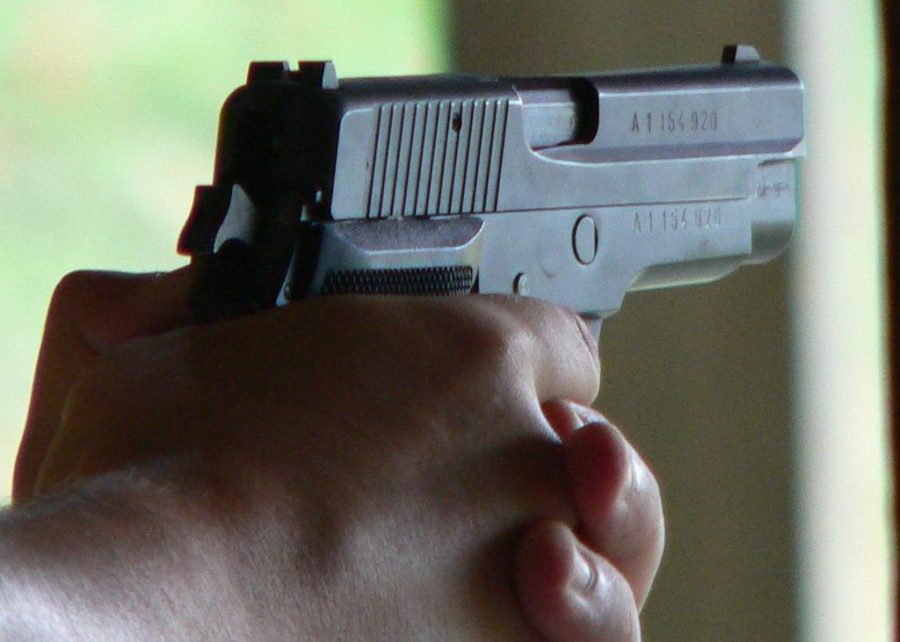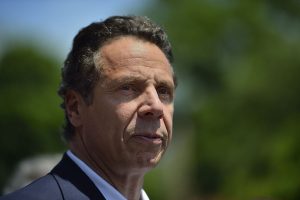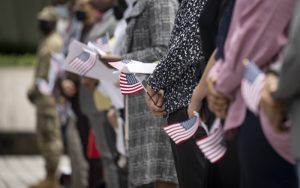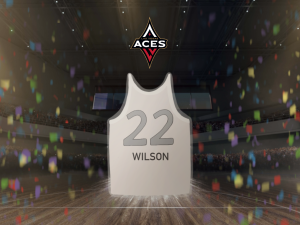New York’s current gun law violates the Second Amendment
November 12, 2021
The U.S. Supreme Court heard oral arguments in the case New York State Rifle & Pistol Association Inc. v. Bruen. The case involves New York’s gun law, which severely restricts ordinary citizens from carrying a handgun in public outside of their home for self-defense.
New York has one of the most restrictive gun laws in the United States, and it’s time for the Supreme Court to strike it down due to its clear constitutional violations concerning the Second Amendment.
In order to receive a license to carry a firearm in public for self-defense, applicants must prove that they have a proper cause.
The standard itself is vaguely defined and allows the state to reject license applications at its discretion. Most states have “shall issue” systems, which remove all arbitrary bias and discretion, while New York has a “may issue” system.
Imposing so many restrictions to obtain a license shows that the constitutional right to keep and bear arms for self-defense, as correctly affirmed in McDonald v. Chicago and District of Columbia v. Heller, is more burdened and disfavored in New York than most other civil rights. New York’s law is far too prohibitory.
During the arguments, Justice Brett Kavanaugh made several good points as he questioned the respondents’ attorney.
He said that “if it’s the discretion of an individual officer [to approve applications], that seems inconsistent with an objective constitutional right.”
To speak and freely exercise First Amendment rights in public, no special permit is needed. While it’s generally true that balancing the public safety factor is important when it comes to the Second Amendment, the fact that these two amendments are treated differently is inconsistent with how the Founding Fathers intended for all amendments to be equally treated.
It should be enough to say that because someone lives in or has to frequently visit areas with violent crimes, they should have proper cause to carry a handgun for self-defense. The respondents’ attorney argued that it depends on how urban or densely populated an area is, along with how many armed police officers there are.
Given that New York City is more dangerous than upstate New York, city residents are more likely to want, even need, to rely on their Second Amendment rights especially when there are no police officers nearby, yet it’s harder to get a carry license there than in upstate New York.
The likelihood of someone getting approved, even with good moral character and no criminal record, is low.
The petitioners, Robert Nash and Brandon Koch were both denied carry permits despite having experience with firearms, which should have been sufficient for approval. Just because they didn’t face a unique danger to their lives, it shouldn’t be a valid rejection of their right to bear arms in public for self-defense.
Giving licensing officers the discretion and power to decide which citizens may exercise a fundamental right expressed in the Constitution is blatantly antithetical to the Constitution.
Even New Yorkers who “work late at night and wait for public transportation in high-crime areas,” wouldn’t be granted carry permits as a rule, as conceded by the respondents’ attorney. If this kind of biased discretionary system was used on citizens with regard to any other constitutional rights, courts would quickly strike it down.
New York’s law in its current form renders the Second Amendment guarantee to keep and bear arms as a privilege rather than a right. That’s not how it should be.
New York Gov. Kathy Hochul, Mayor Bill de Blasio and Mayor-elect Eric Adams have concerns over this case, primarily from a public safety viewpoint.
While safety is certainly a factor that can be used to determine which specific, sensitive public places can prohibit firearms, such as libraries, it cannot be used to serve as a prior restraint to prevent people from being able to defend themselves with firearms outside of their home completely.
By the end of the arguments, the majority of the justices appeared likely to strike down or limit New York’s law.
If the court correctly rules in favor of the petitioners, New York could be forced to rewrite its law to allow more citizens to carry firearms in public for self-defense, with clearer criteria and less discretionary hurdles.
In addition, New York could become a “shall issue” state, which would compel licensing officers to approve applications if they meet objectively set state requirements, such as meeting the minimum age and having no felony criminal activity.
While some advocates will argue that allowing more citizens to carry firearms in public for self- defense will lead to an increase in uncontrolled gun violence, the result would be the opposite.
Allowing more good citizens to legally carry guns will lead to more deterrence and a higher likelihood that they will be able to successfully defend their families and themselves against criminals.
New York is one of the most restrictive states when it comes to allowing citizens to legally have firearms, yet it declared a statewide gun violence emergency in July ignoring the fact that most of the gun violence is a direct consequence of illegal, not legal, firearms.
Most states, both liberal and conservative states included, adopted a “shall issue” system in recent decades, yet they have less violence than in New York.
More focus should be put on getting illegal firearms off the streets and fighting the increase in crime, rather than pursuing unconstitutional means of preventing law-abiding citizens from carrying handguns in public for the legitimate reason of self-defense.
The Supreme Court has not taken up any major Second Amendment cases in over a decade, and it must use this opportunity now to strike down New York’s law by ruling in favor of the petitioners, and affirming the right of ordinary law-abiding citizens to carry firearms outside of their home for self-defense.








Jerry • Jun 23, 2022 at 5:36 pm
Will NY become a shall issue after the SCOTUS ruling or will it remain may issue.
Vincent C Johnson • May 12, 2022 at 5:24 pm
The right to bare arms means just that.
So……. You get a gun , you get a gun and yes , you to get a gun.
God bless America.
JR • May 8, 2022 at 12:09 am
THE SECOND AMENDMENT OF THE CONSTITUTION SHALL NOT BE VIOLATED BY ANY STATES. NO EXCUSES WHATSOEVER. THE LAW IS THE LAW, ANY OTHER LAW OUTSIDE THE CONSTITUTION LAW SHOULD BE STRIKE DOWN. IT IS TIME THE CONGRESS AND THE SUPREME COURT PUT A STOP TO ALL VIOLATION OF THE LAW.
D J • Apr 13, 2022 at 6:04 pm
How difficult is it to comprehend ‘the right of the People to keep and bear arms’?
The entire NY State gun control system needs to be dismantled in one fell swoop, not around the edges.
Angelo Darden • Apr 10, 2022 at 4:30 pm
We in NYC are confronted with staggering contradictions between the concerns for public safety in theory and in reality. Also the practicality of self defense for the citizen and the concern by police for their own safety.
The original laws were passed during a time of rampant crime (What else is new?) and a public outcry for civic action. Thus, the Sullivan Act was enacted which made it illegal to posess a firearm in NYC without a license and put the authority for licensing in the purview of the NYPD. The actual effect was to prevent members of ethnic minorities (Irish and Italian immigrants and African Americans) from obtaining guns for ANY reason. The law presumes broadly that ANY possesion of a gun without a license is in itself a violent felony regardless if the possessor hadn’t committed any crime or had any intent to. So the law in essence, does not discern the criminal from the law abiding citizen.
As for the police, they are the greatest hinderance in the exercise of the citizen’s right to keep and bear arms. Because the licensing is in the hands of the police and the process both expensive and byzantine, to be charitable (The application fee is $275; non refundable for a pistol license) it lends itself to necessitating hiring legal counsel which the average New Yorker can’t afford. This engenders legal bribery and needing “connections” in order to expedite the process. And the police are generally not inclined to allow more guns on the street, legal or otherwise, so they will find any excuse, however flimsy to deny a permit. It’s not unusual for applicants to reapply more than twice before being reluctantly approved. Even so, the most likely approval would be a target permit which entails the firearm to be transported in a locked box with the bullets separated from the gun; hardly useful as a self defense weapon.
Despite being the largest police force in the world, with an annual budget that rivals the defense budget of most countries, the NYPD will constantly insist that they aren’t funded enough, constantly understaffed and hindered by the mayor and the City Council and the courts but they are effective in reducing crime thus, there’s no need for additional guns on the street for self defense. And yet, they are protected by Supreme Court decision that insist that the police have no constitutional duty to protect you as a citizen. So in between the time you encounter the threat to your person and property and when the police arrive, you’re pretty much left to your own devices and at the criminal’s mercy. Hopefully, you’ll survive the encounter and be able to fill out a report or in the unfortunate instance of your demise, leave enough evidence so that the crime can be investigated, the perpetrator caught and brought before the bar of justice. Which statistically, isn’t very likely. Good luck with that.
In conclusion, the law as presently constituted, does not prevent violent crime and isn’t very effective to keeping guns out of the hands of criminals. In fact it penalizes the citizen for being law abiding while the criminal takes the penalty as the occupational hazard. Most criminals are, indeed, repeat offenders. Even with the additional penalty of 3 years mandatory for committing a crime with a gun, it matters little to the criminal. What’s the difference to him if the sentence is 23 years rather than just 20? But for the citizen, it’s disasterous, not to mention the legal cost, time lost and the potential loss of one’s liberty. This law, is an anachronistic, discriminatory and in my opinion, a hinderance on a constitutionally guaranteeed civil right.
albert zupancic • Apr 3, 2022 at 11:03 am
If you can legally carry a firearm in the field to hunt or to target practice, you should be able to carry with no permit. Im one of the new yorkers who can own firearms but was totally denied my pistol permit.
Rob H • Feb 13, 2022 at 11:26 pm
when will the supreme Court reconvene to decide on NYS right to carry concealed outside the home ?
Eric Colon • Jan 13, 2022 at 5:18 pm
The right to bear arms shall not be infringed. New York is infringing on our constitutional rights and that shouldn’t even be a question, it should be a crime against the state.
Mike Richardson • Nov 27, 2021 at 3:49 am
As a Gun loving collector living in NJ this would be a milestone for NY and I agree with the right to carry for protection… Hoping it passes in the court and will be challenged in NJ next…..
Derryck L. Reddens • Mar 20, 2022 at 11:38 am
You should have the right to bear arms any state I do believe arms Yourself in New York State will keep the crime down The crime is high in New York Let’s give it a Try Everybody have Right to defend themselves Let’s go to the proper channels And the requirements of a Background checks Should not be a problem